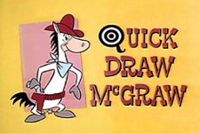One of my all-time favorite cartoons growing up was Quickdraw McGraw and his faithful companion, Babalooi (does that date me?). Do you remember them? Quickdraw was the noble but naïve, quick-on-the-trigger sheriff who fought off wicked desperados who inevitably found their way into his small quiet prairie town. Babalooi was the devoted and wise Mexican companion who always saved Quickdraw from his misguided attempts. In case you didn’ t know, Quickdraw was a horse and Babalooi was a burrito (a donkey, not the Taco Bell kind!)—they were the Don Quixote and Sancho Panza of Saturday mornings.

Sheriff Quickdraw’s first attempt at stopping a criminal type was to cry out, “Cease and desist!” Of course, it never worked—what hardened criminal would desist bad behavior just because you tell them to? Which brings up the question, when learners misbehave, how do you get them to desist without feeling like you have to pull out a Colt 44 and fire a round into the ceiling?
Fortunately, there are effective ways for a teacher to say “Cease and desist” to stop off-task behavior and get learning back on track. A teacher who knows how to stop class disruption before it spreads not only stops the deviancy but at the same time has a positive effect on other learners in the class.
A desist is an action the teacher makes to stop off-task learner behavior. The trick of course, is to use desists which not only stop unwanted behavior but will not also distract the other learners in the class. For example, if a teacher uses angry, punitive desists, then the acting out learner may stop his or her misconduct, but the ripple effect on the other learners will cause an increase in emotional anxiety and disruptive behavior. An effective teacher gives attention to the quality of desist, those characteristics of teacher behavior used to stop disruptive learner conduct. Quality of desist has three indicators: Clarity, Roughness, Task-Force, and Approval-Focus.
Clarity of Desist. Clarity refers to behavior on your part that specifies who the acting-out learner is, what he or she is doing wrong, and why this is improper behavior or what the proper behavior is.
Roughness of Desist. Roughness refers to the way an attempt to stop misbehavior expresses impatience and anger, or ways teacher facial or bodily behavior expresses anger.
Task-Force Desist. The task-force desist refers to ways you direct learners to the task at hand as the desist is given.
Major Deviance Desist. In this teacher behavior the teacher selects the major disruption when two or more deviancies occur simultaneously.
Correct Target Desist. In this behavior the teacher desists the learner who caused the disruption, not a bystander.
Approval-Focus Desist. In this teacher action you make a statement that implies your warmth toward and feeling for the learners. This type of desist loses its effectiveness after about the third grade.
Research in classroom management also found that:
- Soft reprimands are more effective in controlling disruptive behavior than loud reprimands and that when soft reprimands are used, fewer are needed
- Learners who witnessed a punitive or angry desist responded with more behavior disruption than when they observed a desist without roughness
- Task-focused desists resulted in more favorable ripple effect on the conduct of learners than the approval-focus desists
- When a simple reprimand was observed, learners felt the teacher was fairest and able to maintain control.
Learning effective desist techniques is one of the most valuable skills a teacher can master. A teacher who can minimize time spend on classroom and behavior management will increase the time he or she has for actual teaching and instruction. One study found that teachers trained in specific management behaviors, including the use of positive questioning techniques and soft reprimands/desists, decreased the amount of non-instructional time by 20 minutes per day!

SOURCES:
Becker, W.C. et al. Production and elimination of disruptive classroom behavior by systematically varying teachers’ behavior. Journal of Applied Behavior Analysis (1968) 1:35-45.
Borg, W.R. et al. Teacher classroom management skills and pupil behavior. Journal of Experimental Education (1975) 44:52-58.
Emmer, E.T., et al. Effective Classroom Management at the Beginning of the School Year. Elementary School Journal (1980) 80: 219-231.
Kounin, J.S. Discipline and Group Management in Classrooms. New York: Holt, Rinehart and Winston (1970).

1 Response to Using desists in classroom management